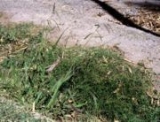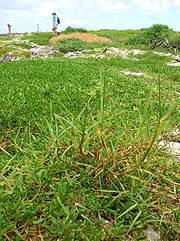
Paspalum
Encyclopedia

Genus
In biology, a genus is a low-level taxonomic rank used in the biological classification of living and fossil organisms, which is an example of definition by genus and differentia...
of the grass family
Family (biology)
In biological classification, family is* a taxonomic rank. Other well-known ranks are life, domain, kingdom, phylum, class, order, genus, and species, with family fitting between order and genus. As for the other well-known ranks, there is the option of an immediately lower rank, indicated by the...
(Poaceae
Poaceae
The Poaceae is a large and nearly ubiquitous family of flowering plants. Members of this family are commonly called grasses, although the term "grass" is also applied to plants that are not in the Poaceae lineage, including the rushes and sedges...
). Commonly known as paspalums, bahiagrasses or dallis grasses most are tall perennial American
Americas
The Americas, or America , are lands in the Western hemisphere, also known as the New World. In English, the plural form the Americas is often used to refer to the landmasses of North America and South America with their associated islands and regions, while the singular form America is primarily...
grasses. They are most diverse in subtropical and tropical regions.
P. scrobiculatum
Paspalum scrobiculatum
Paspalum scrobiculatum is a member of the family Poaceae, commonly called Koda Millet, Kodo Millet or Kodra Millet. It is known as varaku/karuvaraku in Tamil...
(koda, varuka, varuku, etc.) is a millet
Millet
The millets are a group of small-seeded species of cereal crops or grains, widely grown around the world for food and fodder. They do not form a taxonomic group, but rather a functional or agronomic one. Their essential similarities are that they are small-seeded grasses grown in difficult...
locally grown as food grain
GRAIN
GRAIN is a small international non-profit organisation that works to support small farmers and social movements in their struggles for community-controlled and biodiversity-based food systems. Our support takes the form of independent research and analysis, networking at local, regional and...
. Some species
Species
In biology, a species is one of the basic units of biological classification and a taxonomic rank. A species is often defined as a group of organisms capable of interbreeding and producing fertile offspring. While in many cases this definition is adequate, more precise or differing measures are...
, such as Bahia Grass
Bahia grass
Paspalum notatum, also known as Bahia Grass, Common Bahia, or Pensacola Bahia, is a tropical to subtropical perennial grass...
(P. notatum) and P. nicorae, are grown for pasturage, especially with Perennial Forage Peanuts (Arachis glabrata) as companion crops. Bahiagrass has also some significance as a honey plant.
Water Finger-grass (P. vaginatum) resembles Bermudagrass (Cynodon dactylon), but has a higher salinity tolerance and can consume grey water. It is not infrequently used for arena
Arena
An arena is an enclosed area, often circular or oval-shaped, designed to showcase theater, musical performances, or sporting events. It is composed of a large open space surrounded on most or all sides by tiered seating for spectators. The key feature of an arena is that the event space is the...
and golf course
Golf course
A golf course comprises a series of holes, each consisting of a teeing ground, fairway, rough and other hazards, and a green with a flagstick and cup, all designed for the game of golf. A standard round of golf consists of playing 18 holes, thus most golf courses have this number of holes...
turf in warmer coastal regions, e.g. in Baja California
Baja California
Baja California officially Estado Libre y Soberano de Baja California is one of the 31 states which, with the Federal District, comprise the 32 Federal Entities of Mexico. It is both the northernmost and westernmost state of Mexico. Before becoming a state in 1953, the area was known as the North...
, Florida
Florida
Florida is a state in the southeastern United States, located on the nation's Atlantic and Gulf coasts. It is bordered to the west by the Gulf of Mexico, to the north by Alabama and Georgia and to the east by the Atlantic Ocean. With a population of 18,801,310 as measured by the 2010 census, it...
, Peru
Peru
Peru , officially the Republic of Peru , is a country in western South America. It is bordered on the north by Ecuador and Colombia, on the east by Brazil, on the southeast by Bolivia, on the south by Chile, and on the west by the Pacific Ocean....
, Texas
Texas
Texas is the second largest U.S. state by both area and population, and the largest state by area in the contiguous United States.The name, based on the Caddo word "Tejas" meaning "friends" or "allies", was applied by the Spanish to the Caddo themselves and to the region of their settlement in...
and Venezuela
Venezuela
Venezuela , officially called the Bolivarian Republic of Venezuela , is a tropical country on the northern coast of South America. It borders Colombia to the west, Guyana to the east, and Brazil to the south...
. Dedicated paspalum cultivar
Cultivar
A cultivar'Cultivar has two meanings as explained under Formal definition. When used in reference to a taxon, the word does not apply to an individual plant but to all those plants sharing the unique characteristics that define the cultivar. is a plant or group of plants selected for desirable...
s such as 'Aloha Seashore' or 'Platinum TE' have been produced for such uses.
Bahiagrasses are also food for caterpillar
Caterpillar
Caterpillars are the larval form of members of the order Lepidoptera . They are mostly herbivorous in food habit, although some species are insectivorous. Caterpillars are voracious feeders and many of them are considered to be pests in agriculture...
s of Lepidoptera
Lepidoptera
Lepidoptera is a large order of insects that includes moths and butterflies . It is one of the most widespread and widely recognizable insect orders in the world, encompassing moths and the three superfamilies of butterflies, skipper butterflies, and moth-butterflies...
such as the Pasture Day Moth
Pasture Day Moth
The Pasture Day Moth, Apina callisto , is a species in the Noctuidae family of moths which is, as its name implies, active during the day, making it unlike most other species in the Noctuidae family...
(Apina callisto), or those of the Dark Palm Dart (Telicota ancilla) which feed on P. urvillei
Paspalum urvillei
Paspalum urvillei is a species of grass known by the common name Vasey's grass, or Vaseygrass. It is native to South America, and it is known in parts of North America as an introduced species. It is a noxious weed where it has been introduced in Hawaii and New Caledonia. It grows well in disturbed...
. Granivorous bird
Bird
Birds are feathered, winged, bipedal, endothermic , egg-laying, vertebrate animals. Around 10,000 living species and 188 families makes them the most speciose class of tetrapod vertebrates. They inhabit ecosystems across the globe, from the Arctic to the Antarctic. Extant birds range in size from...
s often eat paspalum seeds; the Chestnut-breasted Munia
Chestnut-breasted Munia
The Chestnut-breasted Munia , also known as the Chestnut-breasted Mannikin or Bully Bird , is a small brown-backed munia with a black face and greyish crown and nape. It has a broad ferruginous breast bar above a white belly. The species is found in Australia, New Caledonia, Indonesia, and Papua...
(Lonchura castaneothorax) for example is very fond of those of P. longifolium.
Claviceps paspali is a Claviceps sac fungus that grows on Paspalum, producing ergot alkaloids and the tremorgen paspalitrem; it causes "paspalum staggers" poisoning in cattle
Cattle
Cattle are the most common type of large domesticated ungulates. They are a prominent modern member of the subfamily Bovinae, are the most widespread species of the genus Bos, and are most commonly classified collectively as Bos primigenius...
. Tussock Paspalum (P. quadrifarium) is considered a weed in Australia.
Formerly placed here
- Axonopus compressusAxonopus compressusAxonopus compressus Axonopus compressus Axonopus compressus (Blanket grass, Broadleaf carpet grass, Lawn grass, Louisiana grass, Tropical carpet grass; syn. Axonopus compressus (Sw.) P.Beauv. var. australis G.A.Black, Milium compressum Sw., Paspalum compressum (Sw.) Nees, Paspalum platycaule Willd...
(Broad-leaved Carpetgrass), as P. compressum, P. platycaule, P. platycaulon - Axonopus fissifoliusAxonopus fissifoliusAxonopus fissifolius is a grass which is often used as permanent pasture.-External links:**...
(Narrow-leaved Carpetgrass), as P. fissifolium - Digitaria exilis (Fonio), as P. exile

